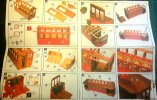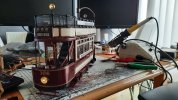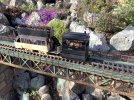Keep in mind these OcCre products are, unusually, of nearly all wooden construction, including items that you would expect to to be made of metal on the full sized prototype, like the chassis frame. This does result in a very light finished product, so you do not need a powerful motor to run them. A mix of laser cut sheet, ply, and different sizes and types of strip wood are used. The fitting of the laser cut parts relies on a hidden tab and slot construction. There are a limited number of small mazak castings for fittings like trolley gear and lamps and rolls of brass wire to produce items like grab handles from. I ditched most of that wire and got appropriate straight K&S wire to work with and fabricated replacements. The models go together well to provide a fine finished product and are well designed. There is no need to fettle laser cut parts to get them to fit, just the need to cut and bend the strip wood accurately as instructed. Instructions are step by step, pictoral, clear, consice and well laid out. They include templates for parts you will be fabricating from the strip wood. These kits have been on the market for some time and were good products from the get go.
Note - with curved body items, single and compound, like the end dashboards, will have to be made up from several sections of bonded, filled and shaped stripwood. Bodywork side "tumble homes" are acheived by bonding the supplied thin lasercut ply sheets to a frame. Decals supplied as printed simply on paper, in colour where required. My method there was to laminate the printed side with a thin clear self adhesive plastic sheet, the reverse with thin double sided tape for the full printed used area. Then I cut them out as required carefully with a scalpel blade. They look surprisingly good
when completed.
Pages from instruction sheet
View attachment 282265
These kits are not for the fainthearted but will produce a fine looking model with a bit of time and patience. I cannot verify the scale accuracy but I would assume OcCre would use a common standard between products in this range. I like your idea of using a proprietary axle hung motor. I bought my kit some 15 years ago and fitted it with a USA Trains motor block. I had to cut an appature in the cabin floor for it to fit. It does not notice much as I clad the exposed part of the motor block with spare strip wood to match the tram's floor. I took me 9 years to summon up the courage (and a process of upskilling by building some simpler wood kits) to get round to building it, but it turned out nice. There is ample room and scope to add addition detailing, like working lights and passengers/crew. Having said that the detailing is very good with the standard kit. Max



